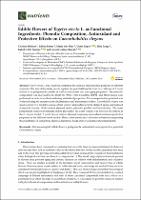Por favor, use este identificador para citar o enlazar este ítem:
https://repositorio.usj.es/handle/123456789/295
| Título : | Edible Flowers of Tagetes erecta L. as Functional Ingredients: Phenolic Composition, Antioxidant and Protective Effects on Caenorhabditis elegans |
| Autor: | Moliner Langa, Ana Cristina



Barros, Lillian 


Dias, Maria Inês 


López Ramos, Víctor 

Langa Morales, Elisa 
Ferreira, Isabel C. F. R 

Gómez-Rincón, Carlota 

|
| Palabras clave : | African marigold; Edible flowers; Polyphenols; Antioxidant; Neuroprotective potential; Caenorhabditis elegans |
| Fecha de publicación: | 18-dic-2018 |
| Editorial : | MDPI, ST ALBAN-ANLAGE 66, CH-4052 BASEL, SWITZERLAND |
| Citación : | Moliner, C.; Barros, L.; Dias, M.I.; López, V.; Langa, E.; Ferreira, I.C.; Gómez-Rincón, C. Edible Flowers of Tagetes erecta L. as Functional Ingredients: Phenolic Composition, Antioxidant and Protective Effects on Caenorhabditis elegans. Nutrients 2018, 10, 2002. |
| Resumen : | Tagetes erecta L. has long been consumed for culinary and medicinal purposes in different countries. The aim of this study was to explore the potential benefits from two cultivars of T. erecta related to its polyphenolic profile as well as antioxidant and anti-aging properties. The phenolic composition was analyzed by LC-DAD-ESI/MSn. Folin-Ciocalteu, DPPH, and FRAP assays were performed in order to evaluate reducing antiradical properties. The neuroprotective potential was evaluated using the enzymes acetylcholinesterase and monoamine oxidase. Caenorhabditis elegans was used as an in vivo model to assess extract toxicity, antioxidant activity, delayed aging, and reduced -amyloid toxicity. Both extracts showed similar phenolic profiles and bioactivities. The main polyphenols found were laricitin and its glycosides. No acute toxicity was detected for extracts in the C. elegans model. T. erecta flower extracts showed promising antioxidant and neuroprotective properties in the different tested models. Hence, these results may add some information supporting the possibilities of using these plants as functional foods and/or as nutraceutical ingredients. |
| URI : | https://repositorio.usj.es/handle/123456789/295 |
| ISSN : | 2072-6643 |
| Aparece en las colecciones: | Artículos de revistas |
Ficheros en este ítem:
| Fichero | Descripción | Tamaño | Formato | |
|---|---|---|---|---|
| nutrients-10-02002.pdf | 1,21 MB | Adobe PDF |  Visualizar/Abrir |
Este ítem está sujeto a una licencia Creative Commons Licencia Creative Commons

